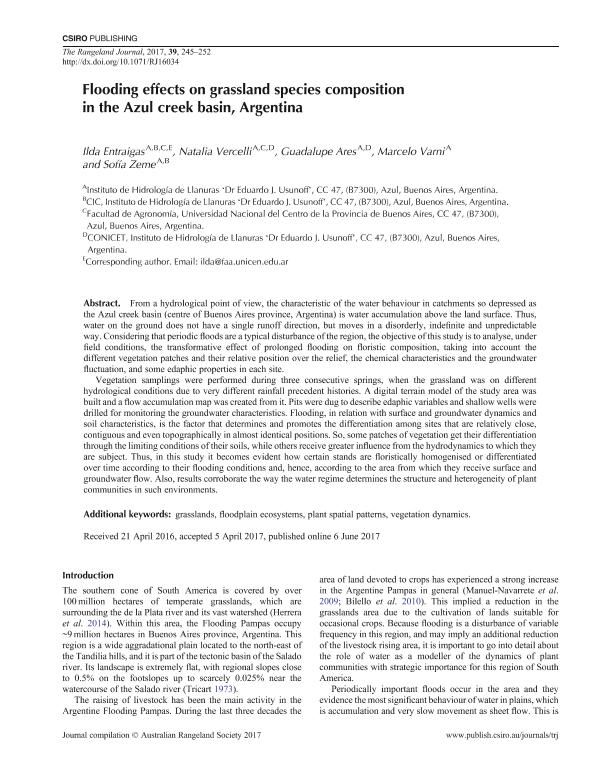Mostrar el registro sencillo del ítem
dc.contributor.author
Entraigas, Ilda

dc.contributor.author
Vercelli, Natalia

dc.contributor.author
Ares, María Guadalupe

dc.contributor.author
Varni, Marcelo Raúl

dc.contributor.author
Zeme, Sofia Aldana

dc.date.available
2018-09-11T17:42:17Z
dc.date.issued
2017-06
dc.identifier.citation
Entraigas, Ilda; Vercelli, Natalia; Ares, María Guadalupe; Varni, Marcelo Raúl; Zeme, Sofia Aldana; Flooding effects on grassland species composition in the Azul creek basin, Argentina; Australian Rangeland Society; Rangeland Journal; 39; 3; 6-2017; 245-252
dc.identifier.issn
1036-9872
dc.identifier.uri
http://hdl.handle.net/11336/59114
dc.description.abstract
From a hydrological point of view, the characteristic of the water behaviour in catchments so depressed as the Azul creek basin (centre of Buenos Aires province, Argentina) is water accumulation above the land surface. Thus, water on the ground does not have a single runoff direction, but moves in a disorderly, indefinite and unpredictable way. Considering that periodic floods are a typical disturbance of the region, the objective of this study is to analyse, under field conditions, the transformative effect of prolonged flooding on floristic composition, taking into account the different vegetation patches and their relative position over the relief, the chemical characteristics and the groundwater fluctuation, and some edaphic properties in each site. Vegetation samplings were performed during three consecutive springs, when the grassland was on different hydrological conditions due to very different rainfall precedent histories. A digital terrain model of the study area was built and a flow accumulation map was created from it. Pits were dug to describe edaphic variables and shallow wells were drilled for monitoring the groundwater characteristics. Flooding, in relation with surface and groundwater dynamics and soil characteristics, is the factor that determines and promotes the differentiation among sites that are relatively close, contiguous and even topographically in almost identical positions. So, some patches of vegetation get their differentiation through the limiting conditions of their soils, while others receive greater influence from the hydrodynamics to which they are subject. Thus, in this study it becomes evident how certain stands are floristically homogenised or differentiated over time according to their flooding conditions and, hence, according to the area from which they receive surface and groundwater flow. Also, results corroborate the way the water regime determines the structure and heterogeneity of plant communities in such environments.
dc.format
application/pdf
dc.language.iso
eng
dc.publisher
Australian Rangeland Society

dc.rights
info:eu-repo/semantics/openAccess
dc.rights.uri
https://creativecommons.org/licenses/by-nc-sa/2.5/ar/
dc.subject
Floodplain Ecosystems
dc.subject
Grasslands
dc.subject
Plant Spatial Patterns
dc.subject
Vegetation Dynamics.
dc.subject.classification
Otras Ciencias de la Tierra y relacionadas con el Medio Ambiente

dc.subject.classification
Ciencias de la Tierra y relacionadas con el Medio Ambiente

dc.subject.classification
CIENCIAS NATURALES Y EXACTAS

dc.title
Flooding effects on grassland species composition in the Azul creek basin, Argentina
dc.type
info:eu-repo/semantics/article
dc.type
info:ar-repo/semantics/artículo
dc.type
info:eu-repo/semantics/publishedVersion
dc.date.updated
2018-09-10T13:18:46Z
dc.journal.volume
39
dc.journal.number
3
dc.journal.pagination
245-252
dc.journal.pais
Australia

dc.description.fil
Fil: Entraigas, Ilda. Universidad Nacional del Centro de la Provincia de Buenos Aires. Rectorado. Instituto de Hidrología de Llanuras - Sede Azul. Provincia de Buenos Aires. Gobernación. Comisión de Investigaciones Científicas. Instituto de Hidrología de Llanuras - Sede Azul; Argentina
dc.description.fil
Fil: Vercelli, Natalia. Universidad Nacional del Centro de la Provincia de Buenos Aires. Rectorado. Instituto de Hidrología de Llanuras - Sede Azul. Provincia de Buenos Aires. Gobernación. Comisión de Investigaciones Científicas. Instituto de Hidrología de Llanuras - Sede Azul; Argentina. Consejo Nacional de Investigaciones Científicas y Técnicas; Argentina
dc.description.fil
Fil: Ares, María Guadalupe. Universidad Nacional del Centro de la Provincia de Buenos Aires. Rectorado. Instituto de Hidrología de Llanuras - Sede Azul. Provincia de Buenos Aires. Gobernación. Comisión de Investigaciones Científicas. Instituto de Hidrología de Llanuras - Sede Azul; Argentina. Consejo Nacional de Investigaciones Científicas y Técnicas; Argentina
dc.description.fil
Fil: Varni, Marcelo Raúl. Universidad Nacional del Centro de la Provincia de Buenos Aires. Rectorado. Instituto de Hidrología de Llanuras - Sede Azul. Provincia de Buenos Aires. Gobernación. Comisión de Investigaciones Científicas. Instituto de Hidrología de Llanuras - Sede Azul; Argentina
dc.description.fil
Fil: Zeme, Sofia Aldana. Universidad Nacional del Centro de la Provincia de Buenos Aires. Rectorado. Instituto de Hidrología de Llanuras - Sede Azul. Provincia de Buenos Aires. Gobernación. Comisión de Investigaciones Científicas. Instituto de Hidrología de Llanuras - Sede Azul; Argentina
dc.journal.title
Rangeland Journal

dc.relation.alternativeid
info:eu-repo/semantics/altIdentifier/url/http://www.publish.csiro.au/RJ/RJ16034
dc.relation.alternativeid
info:eu-repo/semantics/altIdentifier/doi/http://dx.doi.org/10.1071/RJ16034
Archivos asociados
